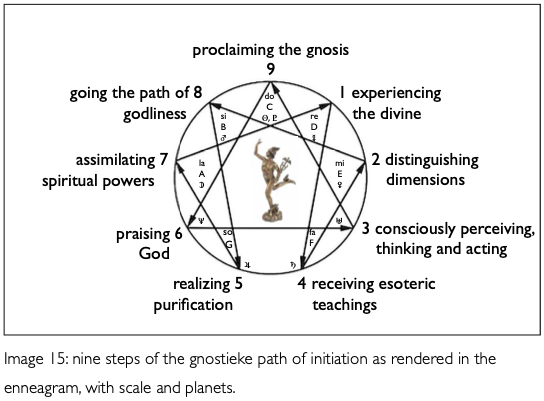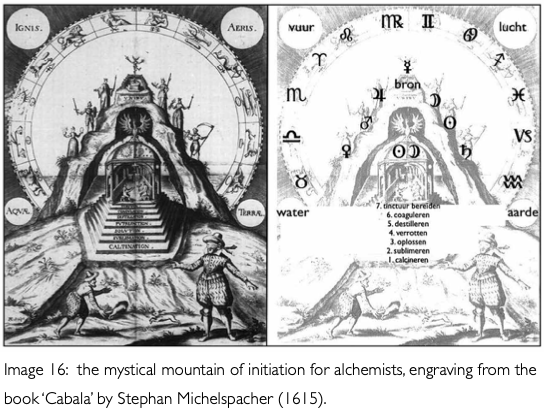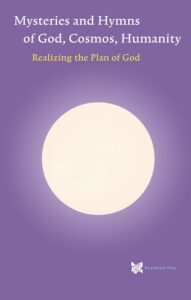Mysteries of God, Cosmos, Humanity, week 8
Reflection: going the path of godliness
Modern culture rejects the belief in a great cosmic plan. We are not actors in some world drama. Life has no script, no playwright, no director, no producer – and no sense. As far as we can scientifically ascertain, the universe is a blind, aimless process full of wild noise, but without meaning. During our infinitely short stay on this one small planet we toil a bit and do something, and after that nothing is ever heard from us again.’
This quote aptly summarizes where humanistic faith and science have brought humanity as a whole: into the total, boundless emptiness, the belief in nothingness. It comes from the controversial book ‘Homo Deus – A Brief History of the Future’ published in 2015 by Yuval Noah Harari, professor of history at the Hebrew University of Jerusalem. Homo Deus is a scientifically well-founded and cleverly written work that invites us to reflect on the future of humanity. The title refers to the successor of the current human species, which would acquire divine qualities thanks to groundbreaking developments, specifically in the area of artificial intelligence and biotechnology. The species name ‘Homo Sapiens’ – the knowing man – could then be changed to ‘Homo Deus’ – the divine man.
In his book, Harari pays ample attention to religion and spirituality, but not to gnosis, not to inner wisdom, which has been propagated for millennia and still now is propagated by esoteric and contemplative traditions that speak of becoming God in a very different way. For example, he considers myths to be fabrications, fiction, and does not see them as revelations of divine origin that can help a human being to start on an inner path. If myths are seen as fabrications, then Harari would be right when about halfway through his book he writes:
‘Egyptian pharaohs and Chinese emperors failed to overcome famine, plague and war, despite millennia of effort. Modern societies managed to do it within a few centuries. […] Modern science
certainly changed the rules of the game, yet it did not simply replace myths with facts. Myths continue to dominate humankind, and science only makes these myths stronger. Instead of destroying the intersubjective reality, science will enable it to control the objective and subjective realities more completely than ever before. Thanks to computers and bioengineering, the difference between fiction and reality will blur, as people reshape reality to match their pet fiction.’
Super-caterpillar
Man has changed the earth to such an extent that there is already talk of a new geological era – the Anthropocene – and it is most probable that, as a consequence of progressing technology, changes to humanity itself will become more and more feasible. This progress means that not only will people be able to cure themselves both physically and psychologically, but they can in many ways improve themselves, so that they are able to do more and to live longer and more happily. All this can be very valuable, but there is also a danger. When a caterpillar is upgraded to a super-caterpillar, it is possible that it becomes so busy with being a super-caterpillar that there is no opportunity to transform into a butterfly. The personality culture then prevents the personality change or transfiguration, which can result only from going a gnostic path.
Hermes Trismegistus invites his pupils to walk the gnostic path. In this connection he speaks of going the way of true godliness, which leads to knowing the divine and refraining from injustice or harm towards any human being. In the previous considerations and in the other two books of this trilogy, this road has already been elucidated from various sides. The titles of the nine chapters of this book give an impression of the stages that can be distinguished.
- experiencing the divine
- distinguishing dimensions
- consciously perceiving, thinking and acting
- receiving esoteric teachings
- realizing purification
- praising God
- assimilating spiritual powers
- going the path of godliness
- proclaiming the gnosis
This may seem like a linear process, in which one phase develops when another phase is achieved and closed. In reality, the formulated steps all take place at the same time to a greater or lesser degree, but for our understanding it is useful to distinguish them from each other. We can imagine the gnostic path as a cyclical process of steps that cannot be seen separately. It could therefore be enlightening to place them in a proven cyclic process model such as that of the enneagram (see image 15).
It is expressed in the triangle of the enneagram that three forces are always required for a process to proceed. To go the gnostic path, it is firstly necessary to spread the gnosis, as shown in point nine of the enneagram: proclaiming the gnosis. Secondly, it is necessary that there are spiritual seekers who are inwardly touched by it and begin to do something with it in their lives. In the enneagram in image 15 this step is formulated at point 3: conscious perceiving, thinking and acting. Thirdly, when going the path of true godliness, a human being should learn to independently attract spiritual powers that accomplish the transfiguration within him. This step is expressed in the enneagram at point 6 as: praising God.
Turn signals, maps and navigation systems
There are many ways to speak or write correctly about the path of true godliness or the path of initiation. It is always about the approach to reality and not about reality itself, which can only be experienced. Many people find such an approach too mental, too intellectual or too rational. On the spiritual path, the touch in the heart sanctuary is indeed fundamental – everything begins with that touch – but in the present stage of human development the head sanctuary must also be included in the process. The choice of a particular scheme is determined mainly by what one wants to emphasize or achieve in a certain context. But without directions, it becomes difficult to get on the road, as it is also very difficult to make a big trip independently without turn signals, maps and navigation systems.
In the past, the path of initiation was often conveyed in symbolic form. Symbolism was used not only because it is most powerful, but also to prevent persecution and mutilations by people who are hostile to the gnosis. At the beginning of the era, a great initiate named Apollonius of Tyana lived and worked in countries around the Mediterranean. This contemporary of Jesus formulated a very veiled twelvefold path of initiation in the form of twelve hours in a text known as the Nuctemeron (see hymn 21). In their manifesto of 1616, called ‘The Alchemical Wedding of Christian Rosycross’, the classical Rosicrucians used a sevenfold division in the form of seven symbolic days. And in their manifesto ‘The call of the Rosicrucian Brotherhood’ from 1614 they mention a threefold division that is very suitable for specifying the process of renewal in Christian terms from the perspective of spirit, soul and personality, and from different dimensions:
- Born of God (personality, 3D)
- Dying in Christ (soul, 4D)
- Revived by the Holy Spirit (spirit, 5D)
In chapter 1 we mentioned a fivefold division, based on the connection between light power, religion, philosophy and spirituality:
- being touched inwardly
- walking together
- understanding intellectually
- growing inwardly
- renewing personally
J. van Rijckenborgh and Catharose de Petri often use a different fivefold division in their books. They call it the fivefold universal gnosis. As with the classic rosicrucians, inner dying – that is, letting go of obstructing identifications and attachments – is central to the awakening and renewal process. The entire process consists of the following five steps, which can be related to the classical planets as described by J. van Rijckenborgh in his book ‘Dei Gloria Intacta, The Christian Initiation Mystery’:
- insight, Mercury initiation, new knowledge arising from awareness;
- yearning for salvation, Venus initiation, new desire aimed at total healing;
- self-surrender, Mars initiation, new will in accordance with the plan of God;
- new mode of life, Jupiter initiation, new action based on inner knowing;
- fulfilment, Saturn initiation, new attainment as a result of the foregoing.
This overview of ‘the way of the stars’ does not include the Sun initiation and the Moon initiation, because for a human being there is no need to do anything for these two fundamental initiations. They come automatically when a person is ready.
The Sun initiation refers to the awakening of the spirit-spark in the heart and the Moon initiation indicates its reflection in the consciousness, thus referring to experiencing what is called ‘the budding of the rose of the heart’. When these two fundamental initiations have taken place, the pupil is faced with the task of being as receptive as possible to the spirit. The poet of the psalms calls that attitude ‘lifting up the eyes to the mountains from which help will come’ (Psalm 121:1, see hymn 18).
Top of the mountain
There is an old Chinese proverb that says: there are many roads that lead to the top of the mountain, but the view is always the same. The symbol of the mountain often appears in the hermetic writings, both in texts and in illustrations. In image 16 we see an engraving from 1615 showing the mountain of initiation. The twelve signs of the zodiac can be recognized from the outside in, as well as: the four elements, the human representations of the seven planets, a staircase with alchemical processes that symbolically represent the steps on the path of initiation, and the mystical marriage between the soul and spirit.
What is the view from the top of the mountain concerning fulfillment on the gnostic path? That question can be answered correctly in many ways, but it is important to realize that each answer is only partial. Zarathustra talks in Yasna 51 about rich perspectives for those seeking the Lord (see hymn 22). The engraving mentioned shows Hermes or Mercury – the messenger of the gods – on the top of the mountain. We could say that the person who has gone the gnostic path experiences a living connection between heaven and earth, through which spiritual powers can ascend and descend. Hermes Trismegistus formulates this as follows:
‘The man who is truly ‘man’ is above the gods or at least fully equal to them in power. For none of the heavenly gods will leave the boundary of heaven to descend to earth. But man raises himself to heaven and measures it. He knows both the sublime things in heaven and the things down below; he assimilates everything with great precision and, what is greatest of all: to ascend to heaven he need not leave the earth. So magnificent and majestic is that which his consciousness encompasses’. (Corpus Hermeticum 12: 74,75)
The name ‘Hermes’ means stone. In ancient Greece, there were three kinds of expressions of stone: upright natural stones as a symbol of fertility, stones as markers for graves and stones as signposts. From this order we can recognize the stages of the path of initiation. First, natural earthly life and its continuation are central. When a human being is ready for it, an inner death follows as a result of being touched. That allows the new human being to develop more and more so that he or she is enabled to show other people the spiritual path, providing the necessary powers, in answer to the following question that is heard inwardly:
‘Now that you have received everything from me, are you not going to those who are worthy of it, in order to serve them as a guide so that, thanks to your mediatorship, the human race may be saved
by God?’ ( Corpus Hermeticum 1:66)
The treatises of Hermes Trismegistus are somewhat mental, but we cannot conclude from this that stories and myths do not matter. True myths originate from the world of the soul and can therefore be experienced as nourishment for the soul. It is certainly not always necessary to be able to interpret them intellectually, but where that is done, explanations can confirm what one already knows inwardly because the symbolic messages are recognized. From that background we can now take note of the shortened version of the myth of the Greek god Hermes, after whom Hermes Trismegistus is named.
The Greek myth of Hermes
Hermes was conceived by the supreme god Zeus with the mountain nymph Maia. Born in a cave in Mount Kyllene in the shepherd’s country of Arcadia, he has the ability to assume not only the shape of a baby, but also that of an adult. Soon after his birth, Hermes leaves the cave as an adult to go on an adventure. He arrives at Piera, sees the beautiful cattle of the sun god Apollo graze there and decides to steal fifty cows and to bring them into a cave. In order to prevent his footprints from being recognized, he ties a piece of oak bark under each foot. He also has the cows walk backwards so that their tracks point into the wrong direction. When Hermes has returned to his birth cave, he sees a turtle blocking the entrance. He kills the animal, robs it of its shield, drills eight holes in it and strings four strings over it. This is how he invented the first musical instrument: the lyre. He is immediately able to make the most beautiful music on the lyre.
When Apollo finds out that his cattle have been stolen, he investigates and after some research he finds out that Hermes is the thief. He goes to the cave and accuses Hermes of theft, while Hermes has now assumed the form of a small child. Maia, who is caring for Hermes now that he has returned, defends her child by claiming that he is far too young to be capable of such a thing. Apollo does not fall for this trick and takes the child to his father Zeus. After a long talk with Hermes, Zeus manages to induce his child to confess guilt and return the stolen cattle to Apollo. As compensation, Hermes donates his homemade lyre to Apollo. Apollo is so pleased with this unexpected gift that he gives him a magic wand in exchange. This staff has the property of uniting opposites. Hermes tests the staff by throwing it on the ground. Immediately two snakes wind around it and remain there forever.
Apollo appoints Hermes as a guide for human souls. He is also given the task of communicating thoughts and messages to the people inspired by the gods. To facilitate this important task as a guide and messenger, the gods bestow on him winged sandals and a winged helmet, which can take him anywhere he wants to go.
Microcosmic reincarnation
In this Greek myth of Hermes we can recognize the spiritual path that a human being can follow. Hermes is both divine and earthly. Although his father is the supreme god, his mother
is a mountain nymph. Hermes can be seen as the human microcosm that alternately takes the form of a baby and an adult. Here we can recognize the principle of microcosmic reincarnation, in which a new mortal personality is constantly evolving in the microcosm. Those personalities have a natural tendency to usurp all kinds of things and achieve their goals through ruse and deception, among other things, so that the microcosm remains bound to the wheel of birth and death. Hermes Trismegistus declares:
‘But the godless soul does not change its nature, it curtails and punishes itself and seeks to enter a new earthly body; a human body, however, as no other body could house a human soul.’
(Corpus Hermeticum 12:57)
As a human being develops, he is no longer guided solely by the impulses emanating from his reptilian brain. He cultivates his quadruple personality – composed of a physical body, an ether body, an astral body and a mental body – and learns to work with it. In the myth we read that Hermes kills the turtle, turns it into a lyre and starts playing the instrument himself.
Apollo, who resides with nine muses on Mount Helicon, can be seen as a symbol of the Universal Brotherhood, always seeking and maintaining connection with humanity on earth to offer it possibilities to lift itself out of its fallen state. Apollo makes Hermes aware that his life is not in accordance with his calling. Hermes gradually begins to see this and gives back verything
that he has stolen. He also donates his lyre to Apollo. Hermes’ personality thus becomes a musical instrument that can be played by the Brotherhood to realize the plan of God. Hermes
then receives from Apollo the staff of the serpents – also called the staff of mercury or the caduceus – as a symbol for the spirit fire that becomes active in the spine and the brain.
It is the sign that he has become connected with the spirit, the fastest of all divine thought creations. This bond, reflected in the opening of the crown chakra, is represented by the helmet
with wings that Hermes receives. Hermes Trismegistus says about this that the spirit-soul has then detached itself from the earthly body and immediately takes on the garment that is her own: the garment of fire. That fiery garment is a new immortal personality that does not have the physical body as its lowest aspect, but the ether body. The immortal personality, as built on the gnostic path, radiates through the old mortal personality and is also known as the resurrection body, the olden wedding garment or the soma psychikon. When that resurrection body has been established, the earthly human being has completed his or her individual gnostic task. Thus we can understand the following enigmatic statement from the Gospel of Philip.
‘In this world, those who put on garments are better than the garments. In the kingdom of heaven, the garments are better than those who put them on’. (The Gospel of Philip 20)
Such a person, having acquired the aforementioned fiery garment, has become a messenger of the gods, to whom the following statement of Hermes Trismegistus applies:
‘If, however, the spirit enters a God-fearing soul, it leads that soul to the light of the Gnosis. Such a soul never wearies of declaring God’s praise in jubilation and, following the example of the Father, of doing good to all men in various ways, in word and deed’. (Corpus Hermeticum 12:62)
Conscious living and acting
How do you follow the way of godliness in the practice of ordinary daily life? Guidelines for this can be found in the many sacred writings of humanity. On the gnostic path it is pointless to just follow authorities, doctrines and rules, because it is about the human being beginning to live consciously and acting from an inner understanding. When the disciples ask Jesus what rules or commandments to observe, he throws it back to them by answering:
‘Do not tell lies, and do not what you hate, for all things are plain in the sight of heaven.’ (The Gospel of Thomas, Logion 6)
A few centuries earlier, Pythagoras said to his students:
‘Never do anything which you do not understand’.
Hermes Trismegistus explains the same thought in ‘Admonition of the Soul’ as follows:
‘If you desire salvation, seek things congruous with your own nature; if you desire destruction, seek things repugnant to your own nature; if you desire perturbation, distraction, and doubt, seek things of both kinds at once.
And therefore, if you, O Soul, are by your own nature luminous and bright, do not accustom yourself to dark things; if you partake of life and speech, do not become familiar with things devoid of life and speech; if you are endowed with intelligence and discernment, do not become familiar with things devoid of intelligence and mental light.
Sorrow is the fruit of sin. Right action brings happiness. If a man plants date-palms, he gets dates, both fresh and dry, and is glad; if he plants willows and briars, he gets no fruit, and loses his labour.
Therefore, O Soul, lay hold on things salutary for you, and abandon things destructive to you; that so you may be received into the number of those souls who enjoy God’s help, who follow the right way, and who will participate in everlasting happiness’.
(Admonition of the Soul, Chapter 8)



